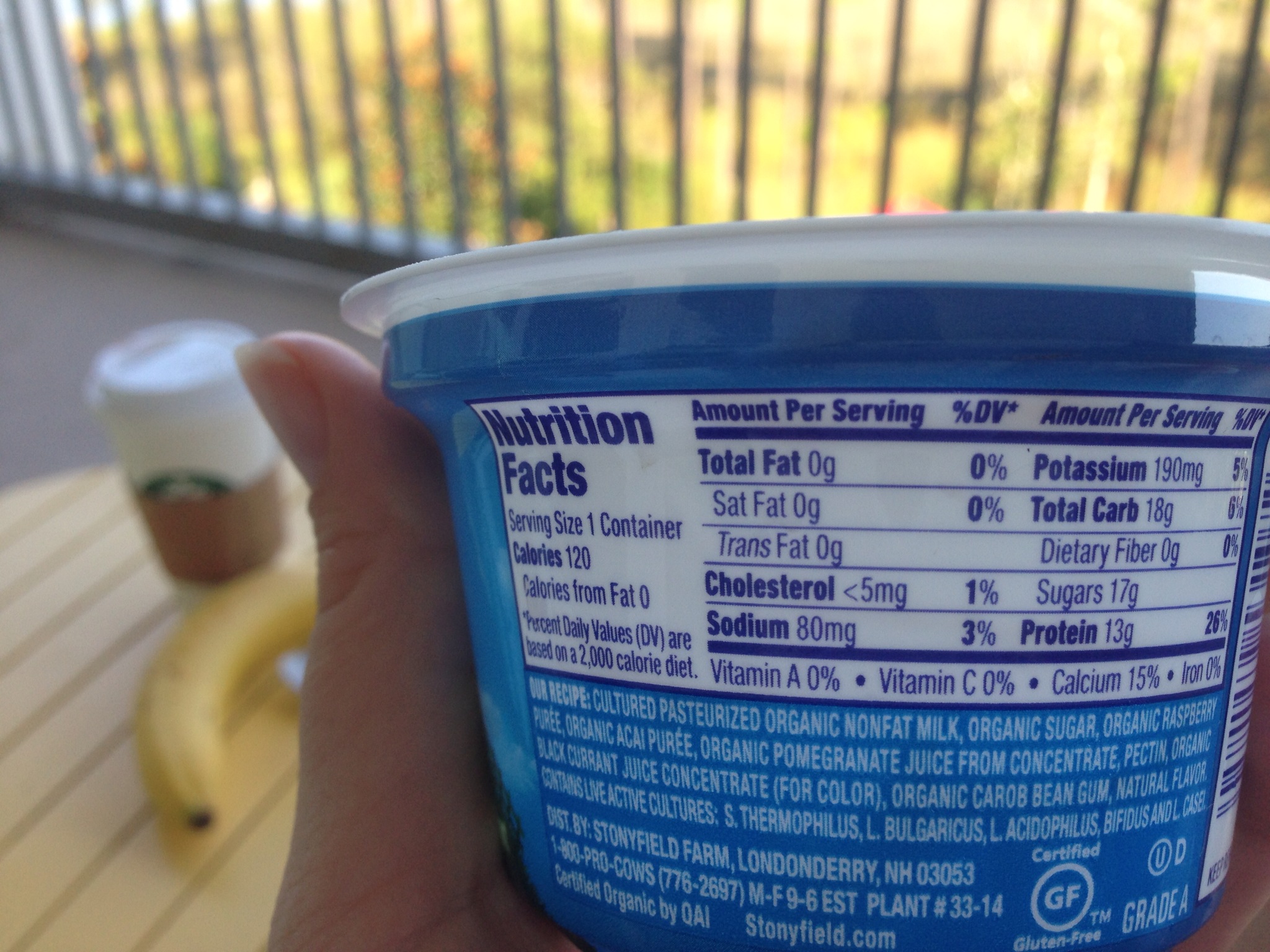
by Amy Mullins | Jul 29, 2016
The Nutrition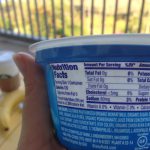 Facts label, seen on packaged bags, boxes, cans, etc., is the consumer information gateway to making healthy choices for ourselves and our families. But let’s face it, for many Americans, interpreting the Nutrition Facts label can be downright confusing, at times, essentially clouding our decision-making abilities.
Facts label, seen on packaged bags, boxes, cans, etc., is the consumer information gateway to making healthy choices for ourselves and our families. But let’s face it, for many Americans, interpreting the Nutrition Facts label can be downright confusing, at times, essentially clouding our decision-making abilities.
Making informed decisions about what you eat every day is an important step in maintaining good nutrition, reducing your risk for heart disease, and keeping your weight in a healthy range. After more than 20 years, the FDA has finalized an improved version of the old label to be in full effect nationwide by mid-2018. First Lady Michelle Obama states, “This is going to make a real difference in providing families across the country the information they need to make healthy choices.”
Key Changes to Look For on the New Label: 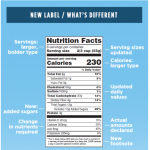
- Added Sugars – One of the more important changes is based on data that shows the difficulty in meeting nutrient needs while staying within calorie limits if you consume more than 10 percent of your total daily calories from added sugar.
- Specific Vitamins & Minerals – Vitamin D and potassium will be required on the label. Calcium and iron will continue to be required. Vitamins A and C will no longer be required but can be included on a voluntary basis.
- Daily Values (%) – Updates on sodium, dietary fiber, and Vitamin D.
- Serving Sizes – Now reflect actual common amounts consumed, not recommended amounts. For example, a serving size for soda previously was 8oz. but is now 12oz.
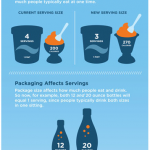 Package Size – Calories and other nutrients will be required to be labeled as one serving because people typically consume it in one sitting.
Package Size – Calories and other nutrients will be required to be labeled as one serving because people typically consume it in one sitting.
- New Format – Highlighting “Calories,” “Servings per container,” and the “Serving size” declaration by increasing the type size and placing the number of calories and the “Serving size” declaration in bold type as well as changing the footnote to better explain the percent Daily Value.
The new label regulations apply to packaged foods except certain meat, poultry, and processed egg products, which are regulated by the U.S. Department of Agriculture’s Food Safety and Inspection Service. To learn more about these important changes, visit the Food and Drug Administration website and read Changes to the Nutrition Facts Label.

by Laurie Osgood | Jul 17, 2016
![Pam-150x150[1]](https://nwdistrict.ifas.ufl.edu/fcs/files/2016/07/Pam-150x1501.jpg) On May 20, 2016, the U.S. Food and Drug Administration released the new Nutrition Facts label requirements for packaged foods. The new version represents the latest in food science research and is designed to make it easier for consumers to get the information they need to make healthy choices. These changes are the first updates to nutrition labels in about 20 years.
On May 20, 2016, the U.S. Food and Drug Administration released the new Nutrition Facts label requirements for packaged foods. The new version represents the latest in food science research and is designed to make it easier for consumers to get the information they need to make healthy choices. These changes are the first updates to nutrition labels in about 20 years.
Larger food manufacturers will be given two years to comply with these new labeling requirements. Smaller manufacturers with sales of less than $10 million will be given an additional year to update the food labels on their products.
What’s New?
Although the Nutrition Facts label will look very similar, the re-designed label will contain several important changes, including slightly larger, bolder type and information consumers need to make better food choices when planning and buying food for their families.
There are five key changes to the Nutrition Facts label that appears on products such as breads, canned and frozen foods, cereals, snacks, desserts, and drinks. These changes appear in the Serving Size & Calories, % Daily Values, Added Sugars, Nutrients, and Footnote sections of the Nutrition Facts label.
The New Label Format: Original vs. New
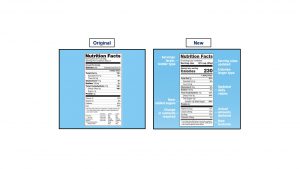
5 Key Changes to the Nutrition Facts Label:
- Larger Font for Serving Size & Calories: The serving size and calorie count that appears on the new label is much larger, making it easier for people to read and identify how many calories they are about to consume. Serving sizes now will be based on what people actually eat, rather than on what the food manufacturer suggests we eat.
- Daily Values: The Daily Values for Sodium, Dietary fiber, and vitamin D will be updated on the Nutrition Facts label. In addition to their Daily Values, the actual amounts of these nutrients are now required. The percent Daily Values (% DV) make it easy for consumers to compare the nutrient content of one product or brand to a similar product.
- Added Sugars: The new label displays Added Sugars in grams as well as %DV to help people monitor their calorie intake. The Dietary Guidelines for Americans 2015-2020 recommends reducing added sugar consumption to less than 10% of calories per day.
- Vitamin D and Potassium: Vitamin D and Potassium are being added to the food label because they are important micronutrients that Americans do not consume enough of. Vitamin D plays a vital role in bone health and potassium can help lower blood pressure. Vitamins A and C will no longer be required because deficiencies of those vitamins are rare.
- Footnote: The footnote contains a standard statement which tells consumers how much a nutrient in a serving of food contributes to a daily 2,000-calorie diet.
Want more Information?
The Family and Consumer Sciences (FCS) Agent at your County UF/IFAS Extension office may have more information on food labeling. For more information, please visit our website at http://sfyl.ifas.ufl.edu/map/index.shtml
References:
U.S. Food and Drug Administration. (2016). Changes to the Nutrition Facts Label. http://www.fda.gov/Food/GuidanceRegulation/GuidanceDocumentsRegulatoryInformation/LabelingNutrition/ucm385663.html
U.S. Food and Drug Administration. (2016). FDA Modernizes Nutrition Facts Label for Packaged Foods. http://www.fda.gov/NewsEvents/Newsroom/PressAnnouncements/ucm502182.html

 Facts label, seen on packaged bags, boxes, cans, etc., is the consumer information gateway to making healthy choices for ourselves and our families. But let’s face it, for many Americans, interpreting the Nutrition Facts label can be downright confusing, at times, essentially clouding our decision-making abilities.
Facts label, seen on packaged bags, boxes, cans, etc., is the consumer information gateway to making healthy choices for ourselves and our families. But let’s face it, for many Americans, interpreting the Nutrition Facts label can be downright confusing, at times, essentially clouding our decision-making abilities.
 Package Size – Calories and other nutrients will be required to be labeled as one serving because people typically consume it in one sitting.
Package Size – Calories and other nutrients will be required to be labeled as one serving because people typically consume it in one sitting.

